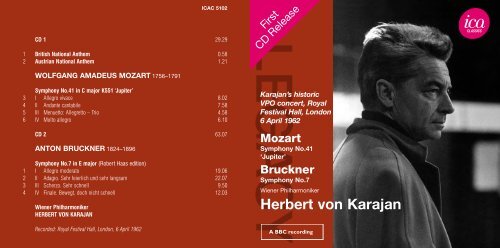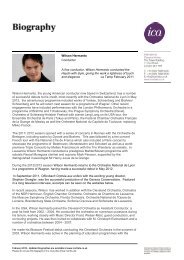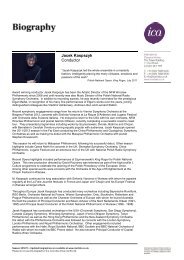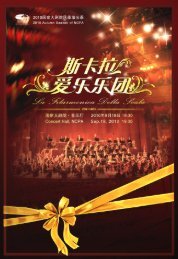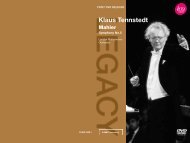to download - International Classical Artists
to download - International Classical Artists
to download - International Classical Artists
You also want an ePaper? Increase the reach of your titles
YUMPU automatically turns print PDFs into web optimized ePapers that Google loves.
ICAC 5102<br />
CD 1 29.29<br />
1 British National Anthem 0.58<br />
2 Austrian National Anthem 1.21<br />
First<br />
CD Release<br />
WOLFGANG AMADEUS MOZART 1756–1791<br />
Symphony No.41 in C major K551 ‘Jupiter’<br />
3 I Allegro vivace 8.02<br />
4 II Andante cantabile 7.58<br />
5 III Menuet<strong>to</strong>: Allegret<strong>to</strong> – Trio 4.58<br />
6 IV Mol<strong>to</strong> allegro 6.10<br />
CD 2 63.07<br />
ANTON BRUCKNER 1824–1896<br />
Symphony No.7 in E major (Robert Haas edition)<br />
1 I Allegro modera<strong>to</strong> 19.06<br />
2 II Adagio. Sehr feierlich und sehr langsam 22.07<br />
3 III Scherzo. Sehr schnell 9.50<br />
4 IV Finale. Bewegt, doch nicht schnell 12.03<br />
Wiener Philharmoniker<br />
HERBERT VON KARAJAN<br />
Karajan’s his<strong>to</strong>ric<br />
VPO concert, Royal<br />
Festival Hall, London<br />
6 April 1962<br />
Mozart<br />
Symphony No.41<br />
‘Jupiter’<br />
Bruckner<br />
Symphony No.7<br />
Wiener Philharmoniker<br />
Herbert von Karajan<br />
Recorded: Royal Festival Hall, London, 6 April 1962
KARAJAN AND THE VIENNA<br />
PHILHARMONIC IN LONDON<br />
‘A packed and raving audience attended last night <strong>to</strong><br />
Herbert von Karajan and the Vienna Philharmonic in the<br />
Royal Festival Hall’ reported Neville Cardus in The<br />
Guardian on 7 April 1962. The hall was certainly packed.<br />
And perhaps by the end we were, indeed, ‘raving’ after<br />
Karajan and this most distinguished of opera orchestras<br />
had offered a glowing account of Wagner’s Meistersinger<br />
Prelude (sadly not preserved) by way of encore.<br />
In 1934 Cardus had written of the Vienna Philharmonic<br />
‘in all the absorbed mastery of its art’ giving glowing<br />
performances of symphonies by Mozart and Brahms under<br />
the direction of Bruno Walter. Such visits had, alas,<br />
remained a rarity. Little wonder, then, that this 1962<br />
concert had about it something of the air of a state visit.<br />
Karajan’s presence added a further dimension. The<br />
Vienna Philharmonic has no principal conduc<strong>to</strong>r but its de<br />
fac<strong>to</strong> head is the Direc<strong>to</strong>r of the Vienna State Opera, a<br />
position Karajan had held since 1957. His reper<strong>to</strong>ry, during<br />
a seven-year reign which has since acquired the reputation<br />
of a golden age, ranged from Monteverdi <strong>to</strong> Pizzetti. A<br />
fabled staging of Debussy’s Pelléas et Mélisande, which<br />
had opened some weeks previously, and new productions<br />
of Tristan und Isolde and Parsifal were particular highlights.<br />
Something of that superbly wrought Wagnerian sound<br />
culture can be heard in this London performance of<br />
Bruckner’s Seventh Symphony.<br />
There were other points of interest <strong>to</strong>o. Karajan with the<br />
Vienna Philharmonic was a rather different conduc<strong>to</strong>r from<br />
Karajan with the Berlin Philharmonic. Deeply versed in the<br />
Vienna Philharmonic’s interpretative traditions and<br />
distinctive sound quality, he was more inclined <strong>to</strong> fashion<br />
his Vienna performances from within, rather than impose<br />
2<br />
them from without. He could also be a very different<br />
conduc<strong>to</strong>r live from the one whose finely honed studio<br />
recordings sold in their millions round the globe.<br />
As a Mozart interpreter Karajan had much in common<br />
with Bruno Walter. His true men<strong>to</strong>r, though, was Richard<br />
Strauss, the classicising romantic whose reading of the<br />
‘Jupiter’ Symphony Karajan’s closely resembles in both<br />
tempo and internal modelling. A recording exists of Karajan<br />
rehearsing the slow movement of the ‘Jupiter’ in Berlin in<br />
1970. From the very first note, a muted F in the first<br />
violins, he requires a particular colour and sustained<br />
beauty of sound. At bar 11, after the lower strings have<br />
played one of the most heavenly six-note phrases in all<br />
Mozart, punctuated by demisemiquaver flurries in the<br />
violins, he intervenes. ‘No, gentlemen, you get that on<br />
every single recording! It’s fine as an exercise in precision<br />
but it’s horrible. Please now: ardent and profound.’ In the<br />
movement’s coda, a further skirl of demisemiquavers for<br />
flutes and bassoons is said <strong>to</strong> be <strong>to</strong>o ‘au<strong>to</strong>matic’. It must,<br />
says Karajan, be ‘like a flurry of tiny wavelets on a smooth<br />
sheet of water’. As Maynard Solomon writes in Mozart: A<br />
Life: ‘Such moments wait <strong>to</strong> be discovered: they are<br />
transitional, passing references <strong>to</strong> pure beauty, captured for<br />
an instant before they sink back in<strong>to</strong> the relative quotidian.’<br />
The performances of both the Mozart and the Bruckner<br />
symphonies are quicker here than on any of Karajan’s<br />
studio recordings. (A reflection, possibly, of the Royal<br />
Festival Hall’s no<strong>to</strong>riously dry acoustic.) They are also freer<br />
in places and given <strong>to</strong> a number of as<strong>to</strong>nishing build-ups<br />
of power. Ot<strong>to</strong> Strasser, who was a member of the Vienna<br />
Philharmonic from 1926 <strong>to</strong> 1967 and who led the second<br />
violins during this concert, <strong>to</strong>ld the present writer, ‘In the<br />
actual performance, especially in operas when he directed<br />
with open eyes, an unbelievable power and tension<br />
radiated from him. I always saw him from very close at<br />
hand: the muscles of his conducting arm were often as<br />
tense as they could be. He suffered sometimes from<br />
painful cramps in the hand, which he overcame with great<br />
difficulty. He never spared himself when standing on the<br />
rostrum.’ Strasser also recalled how in rehearsal Karajan<br />
mixed rigorous analysis with telling eloquence. He recalled<br />
a number of phrases from a Karajan Bruckner rehearsal.<br />
‘The upbeat here, please, especially arduous.’ ‘The<br />
beauty of this passage must be heard <strong>to</strong> lie in its sense<br />
of resignation.’<br />
In 1962 audiences beyond the borders of<br />
Austro-Germany knew little of Karajan’s Bruckner. With the<br />
exception of his epic 1957 Berlin recording of the Eighth<br />
Symphony, his celebrated opus of Bruckner recordings<br />
dates exclusively from the years 1966–89. Perhaps it<br />
comes as no surprise, then, that this London account of the<br />
Seventh Symphony, played by the orchestra Bruckner<br />
himself had known and written for, came as something of<br />
a revelation.<br />
‘Noble Height in Bruckner: Vibrant Vienna<br />
Philharmonic’ ran the headline over a review in London’s<br />
Daily Telegraph. ‘London has not heard a Bruckner<br />
performance of this quality for years,’ wrote critic Donald<br />
Mitchell, who singled out for particular mention Karajan’s<br />
mastery of the long phrase and his ‘quite special sense of<br />
musical continuity’. For some reviewers it was the majestic<br />
unfolding of the symphony’s outer movements which <strong>to</strong>ok<br />
their breath away. For Mitchell it was the slow movement:<br />
in particular the superbly built climax and its brooding<br />
coda, Bruckner’s threnody for the dead Wagner, where the<br />
music-making, Mitchell suggested, was ‘undoubtedly<br />
<strong>to</strong>uched by interpretative genius’.<br />
Richard Osborne<br />
KARAJAN ET LE PHILHARMONIQUE DE<br />
VIENNE À LONDRES<br />
“Une salle comble et délirante entendit hier soir Herbert<br />
von Karajan et le Philharmonique de Vienne au Royal<br />
Festival Hall”, écrit Neville Cardus dans The Guardian<br />
du 7 avril 1962. La salle était certainement comble. Et<br />
peut-être étions-nous vraiment “délirants” à la fin, après<br />
la superbe lecture du Prélude des Maîtres Chanteurs de<br />
Wagner donnée en guise de bis par Karajan et son<br />
orchestre lyrique des plus distingués (mais<br />
malheureusement non conservée).<br />
En 1934, Cardus avait évoqué les radieuses<br />
interprétations de symphonies de Mozart et Brahms<br />
données sous la direction de Bruno Walter par le<br />
Philharmonique de Vienne, “dans <strong>to</strong>ute la maîtrise<br />
concentrée de son art”. De telles visites étaient hélas<br />
restées rares. Il n’est donc pas é<strong>to</strong>nnant que ce concert de<br />
1962 ait eu un peu des allures de visite d’État.<br />
La présence de Karajan y ajoutait une dimension<br />
supplémentaire. Le Philharmonique de Vienne n’a pas de<br />
chef principal, mais son chef de fac<strong>to</strong> est le directeur de<br />
l’Opéra d’État de Vienne, fonction que Karajan occupait<br />
depuis 1957. Son réper<strong>to</strong>ire, au cours d’un règne de sept<br />
ans qui, depuis, s’est fait une réputation d’âge d’or, allait<br />
de Monteverdi à Pizzetti. Une mise en scène légendaire de<br />
Pelléas et Mélisande de Debussy, donnée pour la première<br />
fois quelques semaines auparavant, et de nouvelles<br />
productions de Tristan und Isolde et de Parsifal furent en<br />
particulier des temps forts. Un peu de cette culture sonore<br />
wagnérienne superbement ouvragée s’entend dans cette<br />
interprétation londonienne de la Septième Symphonie<br />
de Bruckner.<br />
Il y avait d’autres aspects intéressants aussi. Karajan<br />
avec le Philharmonique de Vienne était un chef assez<br />
3
différent de Karajan avec le Philharmonique de Berlin.<br />
Profondément versé dans les traditions interprétatives et la<br />
qualité sonore caractéristique du Philharmonique de<br />
Vienne, il était plus enclin à façonner ses interprétations<br />
viennoises de l’intérieur, plutôt que de les imposer de<br />
l’extérieur. Il pouvait également en concert se révéler un<br />
chef très différent de celui dont les enregistrements en<br />
studio très peaufinés se vendaient par millions à travers<br />
le monde.<br />
En tant que mozartien, Karajan avait beaucoup en<br />
commun avec Bruno Walter. Son vrai men<strong>to</strong>r, cependant,<br />
était Richard Strauss; la lecture de la Symphonie “Jupiter”<br />
de Karajan ressemble fortement à celle de ce romantique<br />
classicisant, à la fois dans le tempo et le modelé interne. Il<br />
existe un enregistrement de Karajan répétant le mouvement<br />
lent de la “Jupiter” à Berlin en 1970. Dès la <strong>to</strong>ute première<br />
note, un fa avec sourdine des premiers violons, il demande<br />
une couleur particulière et une beauté soutenue du son.<br />
À la mesure 11, une fois que les cordes graves ont joué<br />
l’une des phrases de six notes les plus divines de <strong>to</strong>ut<br />
Mozart, ponctuée par des figures en triples croches des<br />
violons, il intervient. “Non, messieurs, c’est ce qu’on a sur<br />
<strong>to</strong>us les disques! C’est bien comme exercise de précision,<br />
mais c’est de la crotte. S’il vous plaît, maintenant, ardent<br />
et profond.” Dans la coda du mouvement, une autre figure<br />
en triples croches pour flûtes et bassons est jugée trop<br />
“au<strong>to</strong>matique”. Elle doit être, dit Karajan, “un paisible reflet<br />
sur l’eau, avec seulement de petites vaguelettes”. Comme<br />
l’écrit Maynard Solomon dans Mozart : A Life : “De tels<br />
moments attendent d’être découverts : ce sont des<br />
références transi<strong>to</strong>ires, passagères, à la pure beauté,<br />
saisies pour un instant avant de ressombrer dans le<br />
quotidien relatif.”<br />
Les interprétations des symphonies de Mozart et de<br />
Bruckner sont plus rapides ici que <strong>to</strong>us les enregistrements<br />
en studio de Karajan. (Reflet, peut-être, de l’acoustique<br />
no<strong>to</strong>irement sèche du Royal Festival Hall.) Elles sont<br />
également plus libres par endroits, et soumises à un<br />
certain nombre d’é<strong>to</strong>nnantes progressions en puissance.<br />
Ot<strong>to</strong> Strasser, membre du Philharmonique de Vienne de<br />
1926 à 1967, qui était à la tête des seconds violons<br />
pendant ce concert, m’a confié : “Lors de l’exécution<br />
véritable, sur<strong>to</strong>ut dans les opéras, où il dirigeait les yeux<br />
ouverts, une puissance et une tension incroyables<br />
émanaient de lui. Je le voyais <strong>to</strong>ujours de très près : les<br />
muscles du bras qui dirigeait étaient souvent aussi tendus<br />
que possible. Il souffrait parfois de crampes douloureuses<br />
dans la main, qu’il surmontait avec grande difficulté. Il ne<br />
se ménageait jamais quand il était debout sur l’estrade.”<br />
Strasser rapporte également qu’en répétition Karajan mêlait<br />
l’analyse rigoureuse à l’éloquente rhé<strong>to</strong>rique. Il rapporta un<br />
certain nombre de remarques faites par Karajan lors d’une<br />
répétition Bruckner. “Le levé, ici, s’il vous plaît,<br />
particulièrement ardu.” “On doit entendre que la beauté de<br />
ce passage repose sur son sentiment de résignation.”<br />
En 1962, les auditeurs au-delà des frontières<br />
austro-allemandes connaissaient peu les Bruckner de<br />
Karajan. À l’exception de son épique disque berlinois de la<br />
Huitième Symphonie en 1957, sa célèbre série<br />
d’enregistrements brucknériens date exclusivement des<br />
années 1966–1989. Il n’est donc sans doute pas<br />
surprenant que sa version londonienne de la Septième<br />
Symphonie, jouée par l’orchestre que Bruckner lui-même<br />
avait connu et pour lequel il avait composé, ait été une<br />
espèce de révélation.<br />
“Noble hauteur dans Bruckner : Philharmonique de<br />
Vienne vibrant” : tel était le titre d’un article du Daily<br />
Telegraph de Londres. “Londres n’a pas entendu<br />
d’interprétation brucknérienne de cette qualité depuis des<br />
années”, écrit le critique Donald Mitchell, qui souligne<br />
particulièrement la maîtrise de la longue phrase chez<br />
Karajan, et son “sens très spécial de la continuité<br />
musicale”. Pour certains journalistes, c’est le majestueux<br />
déploiement des mouvements extrêmes de la symphonie<br />
qui leur coupa le souffle. Pour Mitchell, ce fut le<br />
mouvement lent : en particulier la progression<br />
superbement construite et sa sombre coda, l’ode funèbre<br />
de Bruckner pour Wagner, où l’exécution, dit Mitchell, était<br />
“incontestablement <strong>to</strong>uchée par le génie interprétatif”.<br />
Richard Osborne<br />
Traduction : Dennis Collins<br />
4 5<br />
KARAJAN UND DIE WIENER<br />
PHILHARMONIKER IN LONDON<br />
Am 7. April 1962 schrieb Neville Cardus in The Guardian:<br />
“Gestern Abend traten Herbert von Karajan und die Wiener<br />
Philharmoniker vor einem dicht gedrängten und restlos<br />
begeistertem Publikum in der Royal Festival Hall auf.” Der<br />
Saal war in der Tat bis auf den letzten Platz gefüllt und am<br />
Ende, nachdem Karajan und sein wohl bestes aller<br />
Opernorchester als Zugabe noch eine glänzende (und<br />
leider nicht für die Nachwelt erhaltene) Interpretation von<br />
Wagners Meistersinger-Vorspiel abgeliefert hatten, waren<br />
wir wirklich “restlos begeistert”.<br />
Cardus hatte schon 1934 über die Konzerte der Wiener<br />
Philharmoniker berichtet, die “mit all ihrem konzentrierten<br />
künstlerischen Können” unter Bruno Walter fantastische<br />
Aufführungen der Sinfonien von Mozart und Brahms<br />
gegeben hatten. Leider waren solche Besuche eine<br />
Seltenheit geblieben. Es nimmt also nicht wunder, dass<br />
das 1962 stattfindende Konzert etwas von einem<br />
Staatsbesuch hatte.<br />
Karajans Präsenz fügte dem Ganzen eine weitere<br />
Dimension hinzu. Die Wiener Philharmoniker haben keinen<br />
Chefdirigenten an sich, doch der künstlerische Leiter der<br />
Wiener Staatsoper ist gleichzeitig auch ihr Leiter, und<br />
diesen Posten hatte Karajan seit 1957 inne. Sein Reper<strong>to</strong>ire<br />
während seiner siebenjährigen Amtszeit, die rückblickend<br />
oft als goldenes Zeitalter gesehen wird, reichte von<br />
Monteverdi bis Pizzetti. Besondere Highlights waren eine<br />
legendäre Inszenierung von Debussys Pelléas et Mélisande,<br />
welche einige Wochen vor dieser Aufzeichnung eröffnet<br />
worden war, sowie neue Produktionen von Tristan und<br />
Isolde und Parsifal. Auch in dieser Londoner Aufführung<br />
von Bruckners siebter Sinfonie spürt man einen Touch der<br />
fein ausgearbeiteten Wagner’schen Klangkultur.
Es gab noch weitere interessante Aspekte. Der Karajan,<br />
der mit den Wiener Philharmonikern auftrat, war ein völlig<br />
anderer Dirigent, als der Karajan, der mit den Berliner<br />
Philharmonikern auftrat. Da er tiefgreifendes Wissen über<br />
die Interpretationsgepflogenheiten und die klanglichen<br />
Eigenheiten der Wiener Philharmoniker hatte, neigte er<br />
dazu, seine Wiener Aufführungen eher von innen heraus<br />
anzulegen, als ihnen von außen ein Konzept aufzuerlegen.<br />
Und als Dirigent live auf der Bühne war er mitunter ein<br />
völlig anderer, als der Dirigent, dessen ausgefeilte<br />
Studioaufnahmen weltweit millionenfach verkauft wurden.<br />
Als Mozart-Interpret hatte Karajan vieles mit Bruno<br />
Walter gemeinsam. Sein wahrer Men<strong>to</strong>r jedoch war Richard<br />
Strauss, der klassizistische Romantiker, dessen<br />
Interpretation der “Jupiter”-Sinfonie Karajans sowohl im<br />
Bezug auf die Tempi als auch die innere Ausarbeitung stark<br />
ähnelt. Es gibt eine Aufnahme, auf der Karajan 1970 in<br />
Berlin den langsamen Satz aus der “Jupiter”-Sinfonie<br />
probt. Vom ersten Ton an, einem gedämpften F in den<br />
ersten Geigen, verlangt er eine bestimmte Färbung und<br />
anhaltende Schönheit des Klangs. Im elften Takt, nachdem<br />
die tiefen Streicher eine aus sechs Noten bestehende<br />
Phrase gespielt haben, welche von Böen aus<br />
Zweiunddreißigsteln in den Geigen akzentuiert wird – eine<br />
der himmlischsten Phrasen im gesamten Werk Mozarts –,<br />
unterbricht Karajan: “Nein, meine Herren, nein – das gibt’s<br />
auf jeder Platte! Als Übung in Genauigkeit ist es gut, aber<br />
es ist Scheiße. Bitte jetzt, innig und tief…” In der Coda<br />
des Satzes beklagt er, dass das erneute Verlauten der<br />
Zweiunddreißigstel in den Querflöten und Fagotten zu<br />
“au<strong>to</strong>matisch” klinge. Laut Karajan sollte die Stelle<br />
vielmehr an einen “ruhigen Wasserspiegel [erinnern], nur<br />
eine kleine Welle darin”. Wie Maynard Solomon in Mozart:<br />
A Life schrieb: “Solche Momente warten auf ihre<br />
Entdeckung: Es sind vorüberziehende, flüchtige<br />
6<br />
Bezugnahmen auf die reine Schönheit, die sie einen<br />
Moment lang festhalten können, bevor es wieder zum<br />
Zurücksinken ins relativ Alltägliche kommt.”<br />
Die Dauer der hier aufgezeichneten Sinfonien von Mozart<br />
und Bruckner ist kürzer als bei Karajans Studioaufnahmen<br />
(dies hängt möglicherweise mit der berüchtigten trockenen<br />
Akustik der Royal Festival Hall zusammen). Sie sind zum Teil<br />
auch freier und beinhalten einige erstaunlich kraftvolle<br />
Momente. Ot<strong>to</strong> Strasser, der von 1926 bis 1967 Mitglied der<br />
Wiener Philharmoniker war, und während dieses Konzertes<br />
die zweiten Violinen anführte, blickte im Gespräch mit dem<br />
Verfasser dieses Artikels auf seine Arbeit mit Karajan zurück:<br />
“In der eigentlichen Aufführung, besonders in der Oper, wo<br />
er mit offenen Augen dirigierte, [ging] eine unglaubliche<br />
Kraft und Spannung von ihm aus. Ich sah ihn ja immer aus<br />
allernächster Nähe: Die Muskeln des dirigierenden Arms<br />
waren oft bis zum äußersten angespannt, und manchmal litt<br />
er unter anscheinend schmerzhaften Krämpfen der Hand, die<br />
zu überwinden ihn Mühe kostete. Geschont hat er sich nie,<br />
wenn er am Pult stand.” Strasser erinnerte sich auch, wie<br />
Karajan in den Proben rigorose Analyse mit überzeugender<br />
Eloquenz vereinte. Von einer Bruckner-Probe mit Karajan<br />
sind ihm diese Sätze im Gedächtnis geblieben: “Diesen<br />
Auftakt hier bitte besonders mühselig.” “Die Schönheit<br />
dieser Stelle liegt in ihrer Resignation…”<br />
Im Jahr 1962 wusste das Publikum außerhalb der<br />
österreichisch-deutschen Grenzen wenig von Karajans<br />
Bruckner. Abgesehen von seiner epischen Aufnahme der<br />
achten Sinfonie 1957 in Berlin, stammen seine gefeierten<br />
Bruckner-Aufnahmen ausschließlich aus den Jahren<br />
1966–89. Es ist daher vielleicht nicht allzu überraschend,<br />
dass diese Londoner Aufführung der siebten Sinfonie, die<br />
von dem Orchester gespielt wurde, das Bruckner selbst<br />
gekannt hatte und für das er geschrieben hatte, sich als eine<br />
Offenbarung erwies.<br />
“Die edle Erhabenheit Bruckners: Wiener<br />
Philharmoniker in vollem Glanz” lautete der Titel einer<br />
Kritik im Londoner Daily Telegraph. “London hat seit Jahren<br />
keine Bruckner-Aufführung von einer solchen Qualität<br />
gehört”, schrieb der Kritiker Donald Mitchell, der<br />
besonders Karajans meisterliche lange Phrasen und sein<br />
“außergewöhnliches Verständnis musikalischer Kontinuität”<br />
hervorhob. Manchen Kritikern nahm die majestätische<br />
Entfaltung der Ecksätze den Atem. Für Mitchell war es der<br />
langsame Satz: Insbesondere die hervorragend aufgebaute<br />
Klimax und die brütende Coda, Bruckners Klagelied für den<br />
<strong>to</strong>ten Wagner, ließen für ihn keinen Zweifel aufkommen,<br />
dass beim Musizieren “interpretatives Genie” im Spiel war.<br />
Richard Osborne<br />
Übersetzung: Leandra Rhoese<br />
For ICA Classics<br />
Executive Producer/Head of Audio: John Pattrick<br />
Music Rights Executive: Aurélie Baujean<br />
Head of DVD: Louise Waller-Smith<br />
Executive Consultant: Stephen Wright<br />
For Music Preserved Ltd<br />
Chairman: Nicholas Payne<br />
Remastering: Paul Baily (Re.Sound)<br />
This recording derives from tapes donated<br />
<strong>to</strong> the Music Preserved collection held at the<br />
Borthwick Institute of the University of York.<br />
Introduc<strong>to</strong>ry note & translations<br />
© 2013 <strong>International</strong> <strong>Classical</strong> <strong>Artists</strong> Ltd<br />
Booklet editing: WLP Ltd<br />
Art direction: Georgina Curtis for WLP Ltd<br />
2013 BBC, under licence <strong>to</strong> <strong>International</strong> <strong>Classical</strong> <strong>Artists</strong> Ltd<br />
Licensed courtesy of BBC Worldwide from the Music Preserved<br />
Archive<br />
© 2013 <strong>International</strong> <strong>Classical</strong> <strong>Artists</strong> Ltd<br />
For a free promotional CD sampler including<br />
highlights from the ICA Classics CD catalogue,<br />
please email info@icaclassics.com.<br />
Technical Information<br />
Pyramix software<br />
Yamaha 03D mixing console<br />
CEDAR including Re<strong>to</strong>uch<br />
dCS conver<strong>to</strong>rs<br />
TC Electronic M5000 (digital audio mainframe)<br />
Studer A820 1/4" tape machine with Dolby A noise reduction<br />
ATC 100 active moni<strong>to</strong>rs<br />
Mono ADD<br />
WARNING:<br />
All rights reserved. Unauthorised copying, reproduction, hiring,<br />
lending, public performance and broadcasting prohibited.<br />
Licences for public performance or broadcasting may be obtained<br />
from Phonographic Performance Ltd., 1 Upper James Street,<br />
London W1F 9DE. In the United States of America unauthorised<br />
reproduction of this recording is prohibited by Federal law and<br />
subject <strong>to</strong> criminal prosecution.<br />
Made in Austria<br />
7
Also available on CD and digital <strong>download</strong>:<br />
ICAC 5001<br />
Mahler: Symphony No.2 ‘Resurrection’<br />
Stefania Woy<strong>to</strong>wicz · Anny Delorie<br />
Kölner Rundfunkchor u. Rundfunk-Sinfonie-Orchester<br />
William Steinberg<br />
ICAC 5002<br />
Brahms: Ein deutsches Requiem<br />
Mozart: Serenata notturna<br />
Elisabeth Grümmer · Hermann Prey<br />
Kölner Rundfunkchor u. Rundfunk-Sinfonie-Orchester<br />
Ot<strong>to</strong> Klemperer<br />
ICAC 5021<br />
Mahler: Symphony No.3 · Debussy: La Mer<br />
Lucretia West · Kölner Rundfunkchor · Kölner Domchor<br />
Kölner Rundfunk-Sinfonie-Orchester · Dimitri Mitropoulos<br />
Toblacher Komponierhäuschen <strong>International</strong><br />
Record Prize 2011<br />
ICAC 5033<br />
Mahler: Symphony No.3<br />
Waltraud Meier · E<strong>to</strong>n College Boys’ Choir<br />
London Philharmonic Choir & Orchestra<br />
Klaus Tennstedt<br />
Choc de Classica · Diapason d’or<br />
ICAC 5005<br />
Bruckner: Symphony No.3 ed. Nowak<br />
BBC Northern Symphony Orchestra<br />
Kurt Sanderling<br />
ICAC 5006<br />
Verdi: La traviata<br />
Maria Callas · Cesare Valletti · Mario Zanasi<br />
The Covent Garden Opera Chorus & Orchestra<br />
Nicola Rescigno · Supersonic Award (Pizzica<strong>to</strong> Magazine)<br />
ICAC 5034<br />
Beethoven: Symphony No.9<br />
Irmgard Seefried · Rosette Anday · An<strong>to</strong>n Dermota<br />
Paul Schöffler · Wiener Singakademie<br />
Wiener Philharmoniker · Wilhelm Furtwängler<br />
ICAC 5036<br />
Shostakovich: Symphony No.10<br />
Tchaikovsky · Rimsky-Korsakov<br />
USSR State Symphony Orchestra<br />
Evgeny Svetlanov<br />
8<br />
9
ICAC 5047<br />
Mendelssohn: A Midsummer Night’s Dream<br />
Beethoven: Symphony No.8<br />
Kölner Rundfunkchor · Kölner Rundfunk-Sinfonie-Orchester<br />
Ot<strong>to</strong> Klemperer<br />
ICAC 5054<br />
Beethoven: Missa solemnis<br />
Kölner Rundfunkchor<br />
Kölner Rundfunk-Sinfonie-Orchester<br />
William Steinberg<br />
ICAC 5063<br />
Brahms: Symphony No.3<br />
Elgar: Symphony No.1<br />
BBC Symphony Orchestra<br />
Sir Adrian Boult<br />
Supersonic Award (Pizzica<strong>to</strong> Magazine)<br />
ICAC 5070<br />
Boccherini: String Quartet op.44 no.4<br />
Mozart: String Quartet No.17 ‘The Hunt’<br />
Beethoven: String Quartet No.15<br />
Quartet<strong>to</strong> Italiano<br />
ICAC 5055<br />
Schubert: Impromptu in B flat<br />
Beethoven: Piano Sonatas Nos.6 & 29<br />
Wilhelm Backhaus<br />
ICAC 5062<br />
Schumann: Piano Concer<strong>to</strong><br />
Beethoven: Eroica Variations · Piano Sonata No.30<br />
Kölner Rundfunk-Sinfonie-Orchester · Joseph Keilberth<br />
Annie Fischer<br />
ICAC 5076<br />
Wolf: Italienisches Liederbuch<br />
Janet Baker · John Shirley-Quirk<br />
ICAC 5077<br />
Brahms: Piano Concer<strong>to</strong> No.2<br />
Debussy · Prokofiev<br />
Kölner Rundfunk-Sinfonie-Orchester<br />
Mario Rossi · Emil Gilels<br />
10 11
ICAC 5078<br />
Rachmaninov: Symphony No.2<br />
Bernstein: Candide – Overture<br />
Philharmonia Orchestra<br />
London Symphony Orchestra<br />
Evgeny Svetlanov<br />
ICAC 5079<br />
Grieg · Liszt: Piano Concer<strong>to</strong>s<br />
Lully · Scarlatti<br />
Orchestre National de l’ORTF<br />
Georges Tzipine · André Cluytens<br />
Georges Cziffra<br />
ICAC 5084<br />
Beethoven: Piano Sonatas Nos. 3 & 29<br />
‘Hammerklavier’<br />
Bagatelles op.126 nos. 1, 4 & 6<br />
Svia<strong>to</strong>slav Richter<br />
ICAC 5086<br />
Beethoven: Piano Concer<strong>to</strong>s Nos. 2 & 4<br />
Sinfonia Varsovia · Jacek Kaspszyk<br />
Ingrid Jacoby<br />
ICAC 5080<br />
Mahler: Das klagende Lied<br />
Janáček: The Fiddler’s Child<br />
Teresa Cahill · Janet Baker · Robert Tear · Gwynne Howell<br />
BBC Symphony Chorus and Orchestra<br />
Gennadi Rozhdestvensky<br />
ICAC 5081<br />
Schumann: Symphony No.4<br />
Debussy: Le Martyre de Saint Sébastien – Suite<br />
La Mer<br />
Philharmonia Orchestra<br />
Guido Cantelli<br />
ICAC 5087<br />
Beethoven: Symphony No.3 ‘Eroica’<br />
Smetana: The Bartered Bride – Overture<br />
Orquesta Nacional de España<br />
Orchestre de la Suisse Romande<br />
Ataúlfo Argenta<br />
ICAC 5090<br />
Brahms: Symphony No.1<br />
Martinů: Symphony No.4<br />
Radio-Sinfonieorchester Stuttgart des SWR<br />
Klaus Tennstedt<br />
12<br />
13
ICAC 5091<br />
Mahler: Symphony No.5<br />
Kölner Rundfunk-Sinfonie-Orchester<br />
Hans Rosbaud<br />
ICAC 5092<br />
Tchaikovsky: Piano Concer<strong>to</strong> No.1<br />
Brahms: Piano Concer<strong>to</strong> No.2<br />
Kölner Rundfunk-Sinfonie-Orchester<br />
Sir Georg Solti · Ot<strong>to</strong> Klemperer<br />
Géza Anda<br />
ICAC 5095<br />
Beethoven: Piano Sonata No.3<br />
Ravel: Valses nobles et sentimentales<br />
Chopin: Nocturne op.27 no.2 · Ballade No.1<br />
Arthur Rubinstein<br />
ICAC 5096<br />
Schubert: Symphony No.4 ‘Tragic’<br />
Britten: Serenade · Sibelius: Symphony No.2<br />
Gerald English · Hermann Baumann<br />
Kölner Rundfunk-Sinfonie-Orchester<br />
Sir John Barbirolli<br />
ICAC 5093<br />
Brahms: Symphony No.4<br />
Mendelssohn: Symphony No.4 ‘Italian’<br />
BBC Symphony Orchestra<br />
Royal Philharmonic Orchestra<br />
Sir Adrian Boult<br />
ICAC 5094<br />
Mahler: Symphonies 1 & 8<br />
National Choir of the Ukraine ‘Dumka’<br />
Netherlands Philharmonic Orchestra<br />
Hartmut Haenchen<br />
ICAC 5103<br />
Mozart: Piano Concer<strong>to</strong>s Nos. 15 & 20<br />
Radio-Sinfonieorchester Stuttgart des SWR<br />
An<strong>to</strong>ine de Bavier<br />
Arturo Benedet<strong>to</strong> Michelangeli<br />
ICAC 5104<br />
Beethoven: Piano Concer<strong>to</strong> No.5 ‘Emperor’<br />
Variations WoO78 & WoO79<br />
Andante favori · Bagatelles op.119<br />
Sinfonia Varsovia · Jacek Kaspszyk<br />
Ingrid Jacoby<br />
14<br />
15


